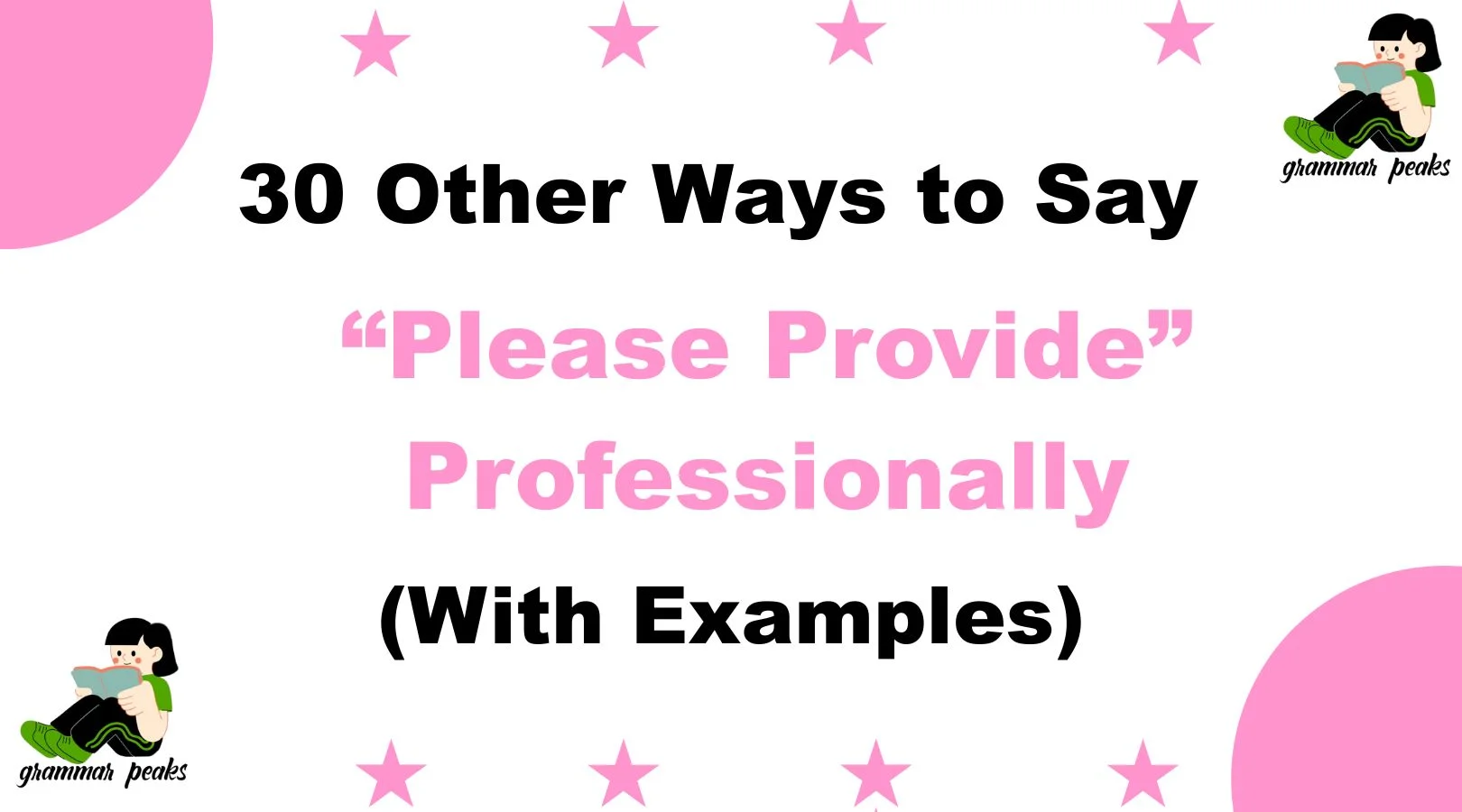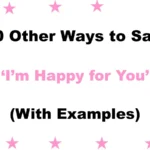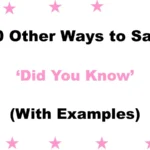In professional settings, how you ask for something matters just as much as what you’re asking for. Saying “please provide” is common in emails, reports, and formal conversations, but repeating it can sound stiff or overly direct. Whether you’re requesting documents, feedback, or details, using varied and polished alternatives helps you sound respectful, collaborative, and clear. Below are 30 professional ways to say “please provide,” with examples and tone guidance for every scenario.
What Does “Please Provide” Mean?
“Please provide” is a formal way to ask someone to give or submit something—usually documents, information, clarification, or feedback. It’s commonly used in business communication, particularly in emails, official requests, and project updates.
When to Use “Please Provide”
Use “please provide” when you’re asking someone to send or supply something in a formal or structured context. Examples include requesting supporting documents, details for a project, or answers to specific questions.
Is It Professional/Polite to Say “Please Provide”?
Yes, it is professional and polite—but it can come across as slightly rigid or impersonal if overused. Depending on the tone you want to convey, alternatives might feel warmer, more collaborative, or more courteous while keeping the message clear.
Pros and Cons of Saying “Please Provide”
Pros:
- Clear and direct
- Universally understood in formal communication
- Appropriate for instructions, forms, and official requests
Cons:
- Can sound robotic or impersonal
- Lacks warmth in ongoing conversation
- Not ideal for softer, more persuasive messaging
Synonyms For “Please Provide”
- Kindly Share
- Could You Please Send
- Would You Mind Sharing
- Please Forward
- I’d Appreciate It If You Could Provide
- Please Send Over
- Can You Provide
- Would You Be Able to Send
- May I Have
- Would You Kindly Provide
- Please Submit
- Please Attach
- Please Ensure You Include
- I’d Be Grateful If You Could Share
- Please Email Me
- Do Send Across
- Please Deliver
- We’d Appreciate It If You Could Send
- At Your Earliest Convenience, Please Share
- Please Furnish
- Kindly Upload
- I’ll Need You to Provide
- Please Make Sure to Include
- Could You Kindly Attach
- Feel Free to Send Me
- Share With Me
- Reach Out With
- Could You Kindly Send Over
- Please Pass Along
- Please Ensure Submission Of
1. Kindly Share
Definition: A polite and slightly warmer version of “please provide.”
Explanation: Often used in professional emails or team communication.
Example: “Kindly share the updated report by Friday.”
Best Use: Internal emails, polite professional requests.
Worst Use: Legal or technical documents needing directness.
Tone: Courteous, professional.
2. Could You Please Send
Definition: A question-based, respectful request.
Explanation: Makes the tone more collaborative and polite.
Example: “Could you please send the invoices for April?”
Best Use: Client communication, external partners.
Worst Use: Instructional or process documentation.
Tone: Polite, gentle.
3. Would You Mind Sharing
Definition: A softer, more deferential way to ask.
Explanation: Shows extra respect and softens the ask.
Example: “Would you mind sharing the feedback from your meeting?”
Best Use: Requests from higher-ups, sensitive asks.
Worst Use: Situations needing urgency or formality.
Tone: Humble, respectful.
4. Please Forward
Definition: A direct request to pass along something.
Explanation: Used when the person isn’t the originator of the item.
Example: “Please forward the signed contract to legal.”
Best Use: Document handling, approval chains.
Worst Use: When collaboration or explanation is needed.
Tone: Direct, administrative.
5. I’d Appreciate It If You Could Provide
Definition: A respectful way to request information or documents.
Explanation: Adds appreciation to soften the demand.
Example: “I’d appreciate it if you could provide the latest numbers.”
Best Use: Requests from colleagues or team leads.
Worst Use: Highly urgent situations.
Tone: Warm, diplomatic.
6. Please Send Over
Definition: A casual but professional way to request something.
Explanation: Slightly more relaxed than “please provide” but still clear.
Example: “Please send over the client list by noon.”
Best Use: Internal communication, team requests.
Worst Use: Legal or formal documents.
Tone: Friendly, business casual.
7. Can You Provide
Definition: A straightforward and respectful question.
Explanation: Still direct, but framed as a question for softness.
Example: “Can you provide the latest product photos?”
Best Use: General work requests.
Worst Use: When giving instructions to subordinates.
Tone: Neutral, polite.
8. Would You Be Able to Send
Definition: A very polite way to make a request.
Explanation: Useful when asking for something potentially time-consuming.
Example: “Would you be able to send the budget breakdown?”
Best Use: Requesting help or large files.
Worst Use: When urgency is key.
Tone: Courteous, deferential.
9. May I Have
Definition: A respectful and slightly formal phrase.
Explanation: Adds a tone of humility and permission-seeking.
Example: “May I have a copy of your proposal?”
Best Use: Formal written communication.
Worst Use: Technical instructions.
Tone: Formal, respectful.
10. Would You Kindly Provide
Definition: A very formal and polite phrase.
Explanation: Often used in traditional or British English communication.
Example: “Would you kindly provide the login credentials?”
Best Use: Formal emails, government or client-facing work.
Worst Use: Informal team settings.
Tone: Polished, respectful.
11. Please Submit
Definition: A formal phrase often used in applications and processes.
Explanation: Suggests the act of giving something officially.
Example: “Please submit your time sheets by Friday.”
Best Use: HR, compliance, application requests.
Worst Use: Informal collaboration.
Tone: Direct, official.
12. Please Attach
Definition: Used when asking someone to include a file.
Explanation: Direct and common in email communication.
Example: “Please attach the signed agreement to your reply.”
Best Use: Email attachments and file sharing.
Worst Use: Non-digital communication.
Tone: Clear, administrative.
13. Please Ensure You Include
Definition: A formal and clear instruction.
Explanation: Useful when specifics must be included in submission.
Example: “Please ensure you include the purchase order number.”
Best Use: Technical, financial, or regulated settings.
Worst Use: Informal internal emails.
Tone: Firm, process-driven.
14. I’d Be Grateful If You Could Share
Definition: A softer, appreciative request.
Explanation: Combines gratitude and clarity.
Example: “I’d be grateful if you could share your availability.”
Best Use: Asking for cooperation or favors.
Worst Use: Time-sensitive or urgent requests.
Tone: Warm, diplomatic.
15. Please Email Me
Definition: Direct request to send via email.
Explanation: Specifies method of delivery.
Example: “Please email me the updated agenda.”
Best Use: Quick email exchanges, scheduling.
Worst Use: Face-to-face or verbal communication.
Tone: Clear, neutral.
16. Do Send Across
Definition: A more polished and British-style variation of “send.”
Explanation: Slightly formal but still friendly, often used in external communications.
Example: “Do send across the final slides before the meeting.”
Best Use: Emails to clients or external collaborators.
Worst Use: Very formal or legal documentation.
Tone: Polite, professional.
17. Please Deliver
Definition: A formal request, often used for physical items or services.
Explanation: Strong and direct wording for deliverables.
Example: “Please deliver the printed brochures to the front office.”
Best Use: Logistics, physical item requests.
Worst Use: Digital or casual communication.
Tone: Commanding, formal.
18. We’d Appreciate It If You Could Send
Definition: A soft, team-based expression of a request.
Explanation: Frames the request as coming from a group and adds appreciation.
Example: “We’d appreciate it if you could send the survey results by Friday.”
Best Use: Client relationships, group communication.
Worst Use: Time-sensitive or urgent messages.
Tone: Respectful, collaborative.
19. At Your Earliest Convenience, Please Share
Definition: A polite request that also signals timeliness.
Explanation: Indicates importance without pressure.
Example: “At your earliest convenience, please share the signed form.”
Best Use: Formal emails with moderate urgency.
Worst Use: Emergencies or tight deadlines.
Tone: Courteous, slightly formal.
20. Please Furnish
Definition: A very formal synonym for “provide.”
Explanation: Common in legal, financial, or contractual documents.
Example: “Please furnish a copy of the lease agreement.”
Best Use: Contracts, legal writing, finance.
Worst Use: Everyday or casual emails.
Tone: Formal, precise.
21. Kindly Upload
Definition: Request to submit something digitally via a portal or system.
Explanation: Frequently used in HR, education, or SaaS environments.
Example: “Kindly upload your documents to the shared drive.”
Best Use: Digital systems, structured forms.
Worst Use: Verbal or non-digital communication.
Tone: Professional, polite.
22. I’ll Need You to Provide
Definition: A firmer, more authoritative request.
Explanation: Clearly states a need, used in managerial contexts.
Example: “I’ll need you to provide the client notes by EOD.”
Best Use: Direct reports, team expectations.
Worst Use: Peers or clients without softening language.
Tone: Assertive, directive.
23. Please Make Sure to Include
Definition: Instructional phrasing for completeness.
Explanation: Helps clarify expectations during requests.
Example: “Please make sure to include itemized costs in your report.”
Best Use: Instructions, checklists, reviews.
Worst Use: Friendly or informal chats.
Tone: Structured, instructive.
24. Could You Kindly Attach
Definition: A courteous and specific file request.
Explanation: Combines file handling with polite phrasing.
Example: “Could you kindly attach the image files in PNG format?”
Best Use: Email or platform-based document exchanges.
Worst Use: Informal in-person asks.
Tone: Polite, clear.
25. Feel Free to Send Me
Definition: A more casual, inviting alternative.
Explanation: Encourages openness, works well with peers.
Example: “Feel free to send me your slides if you want a second opinion.”
Best Use: Collaborative environments, peer requests.
Worst Use: Strictly formal documents.
Tone: Relaxed, inviting.
26. Share With Me
Definition: Direct but modern and conversational.
Explanation: Common in team and startup cultures.
Example: “Share with me the updated wireframes when ready.”
Best Use: Teams, digital collaboration.
Worst Use: Contracts or external formal writing.
Tone: Friendly, professional.
27. Reach Out With
Definition: A light, people-focused alternative.
Explanation: Works well in service, sales, and HR.
Example: “Feel free to reach out with any questions or documents.”
Best Use: Relationship management, customer service.
Worst Use: Technical requests.
Tone: Open, human-centered.
28. Could You Kindly Send Over
Definition: A polite mix of “kindly” and “send.”
Explanation: Slightly elevated tone compared to casual email phrasing.
Example: “Could you kindly send over the signed NDA?”
Best Use: Working with clients, senior stakeholders.
Worst Use: Internal chats or quick asks.
Tone: Polished, courteous.
29. Please Pass Along
Definition: Request to share or forward something informally.
Explanation: More casual, often used in fast-paced teams.
Example: “Please pass along the deck to marketing once it’s done.”
Best Use: Workflow or team communication.
Worst Use: Legal or financial requests.
Tone: Easygoing, efficient.
30. Please Ensure Submission Of
Definition: A formal, structured instruction.
Explanation: Often seen in academic, HR, or administrative settings.
Example: “Please ensure submission of all forms by the deadline.”
Best Use: Institutions, deadlines, formal documents.
Worst Use: Personal or casual messages.
Tone: Professional, directive.
Conclusion
Choosing the right phrase to replace “please provide” isn’t just about variety—it’s about tone, professionalism, and context. Whether you’re speaking to a client, coworker, supervisor, or vendor, the right alternative can help your message land better, sound more respectful, and even speed up response times.
Some options are more formal and structured (like “Please furnish” or “Ensure submission of”), while others feel warmer or collaborative (such as “Kindly share” or “I’d appreciate it if you could provide”). By adapting your language based on the audience and situation, you not only maintain professionalism—you also build rapport and avoid sounding robotic.
So next time you’re tempted to write “please provide,” take a second to consider which of these 30 polished alternatives might work better for your tone and purpose.
FAQs
Q1: Is “please provide” too formal?
Not necessarily. It’s professional and clear, but in some contexts, it may feel too impersonal or stiff—especially in casual or collaborative settings.
Q2: Which is the most polite alternative to “please provide”?
“Would you be able to send” or “I’d appreciate it if you could share” are excellent polite options that soften the tone.
Q3: Can I use these alternatives in legal or official documents?
For legal or formal documentation, stick to more precise terms like “please furnish,” “submit,” or “ensure submission of.” Avoid overly casual phrases.
Q4: What should I avoid when replacing “please provide”?
Avoid phrases that are too vague or too informal, like “shoot it over” or “drop it in.” These may sound unprofessional in the wrong context.
Q5: Do these alternatives help with email tone?
Absolutely. Using varied, thoughtful language helps your emails feel more considerate and less demanding—especially when dealing with sensitive or repeated requests.






